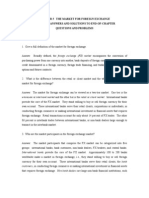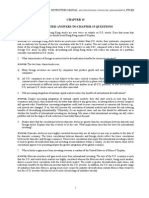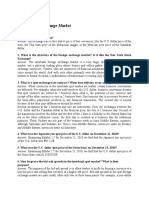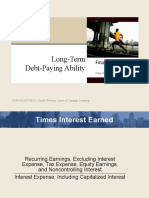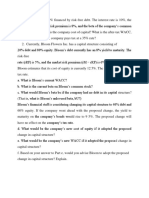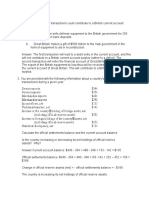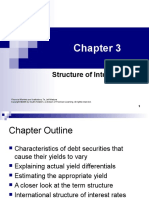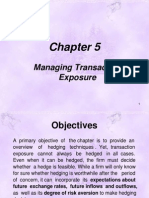Chapter 6
Chapter 6
Uploaded by
TRINHCopyright:
Available Formats
Chapter 6
Chapter 6
Uploaded by
TRINHOriginal Title
Copyright
Available Formats
Share this document
Did you find this document useful?
Is this content inappropriate?
Copyright:
Available Formats
Chapter 6
Chapter 6
Uploaded by
TRINHCopyright:
Available Formats
Chapter
3. Describe how you would calculate a 5-year forward exchange rate of yen per dollar
if you knew the current spot exchange rate and the prices of 5-year pure discount
bonds denominated in yen and dollars. Explain why this has to be the market price.
Answer: The 5-year forward rate would be equal to the spot rate of yen per dollar times the
ratio of the future value in 5 years of one yen to the future value in 5 years of one dollar. The
logic is the following. If you can invest directly in yen for 5 years, you can convert one yen
into the future value of one yen in 5 years. Alternatively, you can convert the one yen into
dollars in the spot foreign exchange market, invest that dollar principal for 5 years to get the
future value of dollars, and contract today to sell those dollars in the forward market to get
back to future yen in 5 years. If the two amounts of future yen differ, there would be an
arbitrage available in which you would borrow future yen where they are cheap and invest in
future yen where they are expensive. Hence, the 5 year forward rate should satisfy
8. Explain why the absence of covered interest arbitrage possibilities can be
characterized by two inequalities in the presence of bidask spreads in the foreign
exchange and external currency markets.
Answer: Because there are bid-ask spreads in the foreign exchange market and in the external
currency market, we do not convert from one currency to another at the same spot or forward
exchange rates, and we do not borrow at the same rate at which we lend. The absence of
covered interest arbitrage therefore is characterized by two inequalities. We cannot profit by
borrowing the domestic currency (at the ask domestic interest rate), converting to the foreign
currency (at the ask spot rate of domestic currency per unit of foreign currency), lending the
foreign currency (at the foreign bid interest rate), and converting to the domestic currency in
the forward market (at the bid forward rate of domestic currency per unit of foreign
currency). Similarly, we cannot profit by borrowing the foreign currency (at the ask foreign
interest rate), converting to domestic currency (at the bid spot rate of domestic currency per
unit of foreign currency), lending the domestic currency (at the domestic bid interest rate),
and converting to the foreign currency forward (at the ask forward rate of domestic currency
per unit of foreign currency).
9. Describe the sequence of transactions required to do a covered interest arbitrage out
of Japanese yen and into U.S. dollars.
2012 Pearson Education, Inc.
Chapter 6: Interest Rate Parity
Answer: To do a covered interest arbitrage out of Japanese yen and into U.S. dollars, one
would borrow yen from the bank at the banks ask interest rate. You would owe interest on
the yen and would have to return the yen principal at the end of the investment horizon. You
would then convert the yen principal into dollars at the ask spot exchange rate of yen per
dollar. You would pay the ask rate because you are buying dollars from the bank with yen.
You would then invest the dollar principal at the banks bid dollar interest rate. Because you
would know how much the dollar interest plus principal would be at the end of the
investment horizon, you would contract to sell that amount of dollars forward for yen. This
forward contract would be made at the banks forward bid rate of yen per dollar. If the
amount of yen that you get from the forward contract exceeds the amount of yen that you
owe the bank from the initial borrowing, you have successfully done a covered interest
arbitrage.
10. Suppose you saw a set of quoted prices from a U.S. bank and a French bank such
that you could borrow dollars, sell the dollars in the spot foreign exchange market
for euros, deposit the euros for 90 days, and make a forward contract to sell euros
for dollars and make a guaranteed profit. Would this be an arbitrage opportunity?
Why or why not?
Answer: It could be an arbitrage opportunity, but it could also reflect the fact that
counterparty risk differs across banks. It may be that the market knows that the default risk of
the French bank is higher than other banks, which has induced the French bank to increase its
promised deposit rates above rates charged by other banks with lower default risk. The
perceived arbitrage opportunity would be illusory in this case.
11. The interest rates on U.S. dollardenominated bank accounts in Mexican banks are
often higher than the interest rates on bank accounts in the United States. Can you
explain this phenomenon?
Answer: Mexico has periodically gotten into balance of payments difficulties and suffered
severe depreciations of the peso. During these periods of crisis, the Mexican government
converted dollar-denominated bank deposits into peso-denominated accounts at exchange
rates that were unfavorable to the depositor, effectively expropriating some of an investors
principal. If there is a possibility of this type of risk or just higher default risk by the Mexican
banks than at U.S. banks, the higher dollar-denominated Mexican deposit rates would be
required to induce depositors to invest in Mexican banks.
13. Suppose you are the French representative of a company selling soap in Canada.
Describe your foreign exchange risk and how you might hedge it with a money
market hedge.
Answer: As a French company, you are interested in euro profits. Selling soap in Canada will
give you Canadian dollar revenues. The euro value of these Canadian dollar revenues will
2012 Pearson Education, Inc.
Chapter 6: Interest Rate Parity
fall in value if the Canadian dollar weakens relative to the euro. To offset this loss in value,
your company should borrow in Canadian dollars.
16. How does a coupon bonds yield to maturity differ from the spot interest rate
that applies to cash flows occurring at the maturity of the bond? When are
the two the same?
Answer: A coupon bonds yield to maturity is the internal rate of return that sets the present
value of the promised coupon payments and principal payment equal to the bond price. The
yield to maturity is therefore a kind of average of the spot interest rates at various maturities.
The yield to maturity equals the spot interest rates at various maturities only when the term
structure of interest rates is flat, that is, when the spot interest rates at various maturities are
all identical.
PROBLEMS
1. In the entry forms for its contests, Publishers Clearing House states, You may have
already won $10,000,000. If the Prize Patrol visits your house to inform you that you
have won, it offers you $333,333.33 each and every year for 30 years. If the interest rate
is 8% p.a., what is the actual present value of the $10,000,000 prize?
Answer: The present value of 30 annual payments of $333,333.33 when discounted at 8% is
This value can be found in Excel by using the function NPV(rate, cashflows), where rate =
8% and cashflows refers to a sequence of 30 cells that all have the value $333,333.33.
2. Suppose the 5-year interest rate on a dollar-denominated pure discount bond is 4.5%
p.a., whereas in France, the euro interest rate is 7.5% p.a. on a similar pure discount
bond denominated in euros. If the current spot rate is $1.08/, what is the value of the
forward exchange rate that prevents covered interest arbitrage?
Answer: We know that the 5-year forward rate must satisfy
3. Carla Heinz is a portfolio manager for Deutsche Bank. She is considering two
alternative investments of EUR10,000,000: 180-day euro deposits or 180-day Swiss
2012 Pearson Education, Inc.
Chapter 6: Interest Rate Parity
francs (CHF) deposits. She has decided not to bear transaction foreign exchange risk.
Suppose she has the following data: 180-day CHF interest rate, 8% p.a., 180-day EUR
interest rate, 10% p.a., spot rate EUR1.1960/CHF, 180-day forward rate,
EUR1.2024/CHF. Which of these deposits provides the higher euro return in 180 days?
If these were actually market prices, what would you expect to happen?
Answer: The euro return to investing directly in euros is
, so the euros
available in 180 days is EUR10,000,000
1.05 = EUR10,500,000. Alternatively, the
EUR10,000,000 can be converted into Swiss francs at the spot rate of EUR1.1960/CHF. The
Swiss francs purchased would equal EUR10,000,000 / EUR1.1960/CHF = CHF8,361,204.
This amount of Swiss francs can be invested to provide a
return over the
next 180 days. Hence, interest plus principal on the Swiss francs is CHF8,361,204 1.04 =
CHF8,695,652. If we sell this amount of Swiss francs forward for euros at the 180-day
forward rate of EUR1.2024/CHF, we get a euro return of CHF8,695,652 EUR1.2024/CHF
= EUR10,455,652. This is less than the return from investing directly in euros.
If these were the actual market prices, you should expect investors to do covered interest
arbitrages. Investors would borrow Swiss francs, which would tend to drive the CHF interest
rate up; they would sell the Swiss francs for euros in the spot foreign exchange market,
which would tend to lower the spot rate of EUR/CHF; they would deposit euros, which
would tend to drive the EUR interest rate down; and they would contract to buy CHF with
EUR in the 180-day forward market, which would put upward pressure on the forward rate of
EUR/CHF. Each of these actions would help bring the market back to equilibrium.
5.Suppose the spot rate is CHF1.4706/$ in the spot market, and the 180-day forward
rate is CHF1.4295/$. If the 180-day dollar interest rate is 7% p.a., what is the
annualized 180-day interest rate on Swiss francs that would prevent arbitrage?
Answer: Interest rate parity requires equality of the return to investing in CHF versus
converting the CHF principal into dollars, investing the dollars, and selling the dollar
principal plus interest in the forward market for CHF:
If we de-annualize the dollar interest rate, we find that the 180 day interest rate is 0.035.
Hence, the Swiss franc interest rate that prevents arbitrage is
If we annualize this value, we find 0.0061
(100)
(360/180) = 1.21%.
6. As a trader for Goldman Sachs you see the following prices from two different
banks:
1-year euro deposits/loans:
6.0% 6.125% p.a.
2012 Pearson Education, Inc.
Chapter 6: Interest Rate Parity
1-year Malaysian ringgit deposits/loans:10.5% 10.625% p.a.
Spot exchange rates:
MYR 4.6602 / EUR MYR 4.6622 / EUR
1-year forward exchange rates:
MYR 4.9500 / EUR MYR 4.9650 / EUR
The interest rates are quoted on a 360-day year. Can you do a covered interest
arbitrage?
?=X
Answer: We need to check the two inequalities that characterize the absence of covered
interest arbitrage. In the first, we will borrow euros at 6.125%, convert to ringgits in the spot
market at MYR4.6602 / EUR, invest the ringgits at 10.5%, and sell the ringgit principal plus
interest forward for euros at MYR4.9650 / EUR. We find that
Thus, it is not profitable to try to arbitrage in this direction as the amount that we would
owe is greater than the amount that we would gain.
Lets try the other direction, arbitraging out of ringgits into euros and covering the
foreign exchange risk. We will borrow ringgits at 10.625%, convert to euros in the spot
market at MYR4.6622 / EUR, invest the euros at 6.0%, and sell the euro principal plus
interest forward for ringgits at MYR4.9500 / EUR. We find that
Thus, there is a possible arbitrage opportunity because the amount that we owe from
borrowing ringgits is less than the amount that we gain by converting from ringgits to euros,
investing the euros, and covering the transaction exchange risk with a forward sale of euros
for ringgits.
7. As an importer of grain into Japan from the United States, you have agreed to pay
$377,287 in 90 days after you receive your grain. You face the following exchange
rates and interest rates: spot rate, 106.35/$, 90-day forward rate 106.02/$, 90-day
USD interest rate, 3.25% p.a., 90-day JPY interest rate, 1.9375% p.a.
a. Describe the nature and extent of your transaction foreign exchange risk.
Answer: As a Japanese grain importer, you are contractually obligated to pay $377,287 in
90 days. Any weakening of the yen versus the dollar will increase the yen cost of your
grain. The possible loss is unbounded.
b. Explain two ways to hedge the risk.
2012 Pearson Education, Inc.
Chapter 6: Interest Rate Parity
Answer: You could hedge your risk by buying dollars forward at 106.02/$. Alternatively,
you could determine the present value of the dollars that you owe and buy that amount of
dollars today in the spot market. You could borrow that amount of yen to avoid having to
pay today.
c. Which of the alternatives in part b is superior?
Answer: If you do the forward hedge, you will have to pay
106.02/$ $377,287 = 39,999,967.74
in 90 days. If you do the money market hedge, you first need to find the present value of
$377,287 at 3.25%. The de-annualized interest rate is (3.25/100) (90/360) = 0.008125.
Thus, the present value is
$377,287 / 1.008125 = $374,246.25
Purchasing this amount of dollars in the spot market costs
106.35/$ $374,246.25 = 39,801,088.69
To compare this value to the forward hedge, we must take its future value at 1.9375% p.a.
The de-annualized interest rate is (1.9375/100) (90/360) = 0.00484375, and the future
value is
39,801,088.69 (1.00484375) = 39,993,875.21
The cost of the money market hedge is essentially the same as the cost of the forward
hedge because interest rate parity is satisfied.
2012 Pearson Education, Inc.
You might also like
- FINA3020 Assignment3Document5 pagesFINA3020 Assignment3younes.louafiiizNo ratings yet
- Asset Allocation 5E (PB): Balancing Financial Risk, Fifth EditionFrom EverandAsset Allocation 5E (PB): Balancing Financial Risk, Fifth EditionRating: 4 out of 5 stars4/5 (13)
- Øving 8Document5 pagesØving 8Aurora SauarNo ratings yet
- International Monetary and Financial EconomicsDocument18 pagesInternational Monetary and Financial EconomicsGustavo H. Torres100% (1)
- Suggested Solutions Chapter 5Document5 pagesSuggested Solutions Chapter 5hayat0150% (2)
- Chapter 18Document17 pagesChapter 18Summer VongNo ratings yet
- Building Warehousing CompetitivenessDocument18 pagesBuilding Warehousing CompetitivenesspenelopegerhardNo ratings yet
- International FInanceDocument3 pagesInternational FInanceJemma JadeNo ratings yet
- Foreign Currency TranslationDocument38 pagesForeign Currency TranslationAnmol Gulati100% (1)
- Topic 4. The Characteristics of The Opportunity Set Under Risk QuestionsDocument3 pagesTopic 4. The Characteristics of The Opportunity Set Under Risk QuestionsZei Di Jay0% (2)
- International Financial Management - Mgt645Document11 pagesInternational Financial Management - Mgt645meetpalNo ratings yet
- ER Ch05 Solution ManualDocument14 pagesER Ch05 Solution Manualsupering143No ratings yet
- FINC3014 Topic 10 SolutionsDocument4 pagesFINC3014 Topic 10 Solutionssuitup100No ratings yet
- Investing for Interest 14: Individual Treasury Bonds vs. Treasury Bond Funds: Financial Freedom, #174From EverandInvesting for Interest 14: Individual Treasury Bonds vs. Treasury Bond Funds: Financial Freedom, #174No ratings yet
- Bekaert 2e SM Ch10Document11 pagesBekaert 2e SM Ch10Xinyi Kimmy LiangNo ratings yet
- Part 1 2nd AttemptDocument16 pagesPart 1 2nd AttemptCuitlahuac TogoNo ratings yet
- Solutions Chapter 15 Internationsl InvestmentsDocument12 pagesSolutions Chapter 15 Internationsl Investments'Osvaldo' RioNo ratings yet
- Chapter 4 Answer SheetDocument10 pagesChapter 4 Answer SheetJoan Gayle BalisiNo ratings yet
- Swaps: Problem 7.1Document4 pagesSwaps: Problem 7.1Hana Lee50% (2)
- Measuring Exposure To Exchange Rate FluctuationsDocument38 pagesMeasuring Exposure To Exchange Rate FluctuationsImroz MahmudNo ratings yet
- International Financial Management - Geert Bekaert Robert Hodrick - Chap 02 - SolutionDocument4 pagesInternational Financial Management - Geert Bekaert Robert Hodrick - Chap 02 - SolutionFagbola Oluwatobi OmolajaNo ratings yet
- Chapter 6 Bond - Assignment AnswerDocument6 pagesChapter 6 Bond - Assignment AnswerRoger RogerNo ratings yet
- The Mock Test2923Document15 pagesThe Mock Test2923elongoria278No ratings yet
- Chapter 13 AnswersDocument5 pagesChapter 13 Answersvandung19100% (1)
- Long-Term Debt-Paying AbilityDocument26 pagesLong-Term Debt-Paying AbilityOman SherNo ratings yet
- NN 5 Chap 4 Review of AccountingDocument10 pagesNN 5 Chap 4 Review of AccountingNguyet NguyenNo ratings yet
- BBA2Document2 pagesBBA2Govardhan RaoNo ratings yet
- Time Value of Money Notes Loan ArmotisationDocument12 pagesTime Value of Money Notes Loan ArmotisationVimbai ChituraNo ratings yet
- Balance of Payments:: Chapter Objectives & Lecture Notes FINA 5500Document27 pagesBalance of Payments:: Chapter Objectives & Lecture Notes FINA 5500Anonymous H0SJWZE8100% (1)
- Report On Foreign Exchange Practice of ICB Islamic BankDocument122 pagesReport On Foreign Exchange Practice of ICB Islamic BankMahadi HasanNo ratings yet
- Risk and Return AssignmentDocument2 pagesRisk and Return AssignmentHuzaifa Bin SaeedNo ratings yet
- Chapter 4 Return and Risk: Analyzing The Historical RecordDocument4 pagesChapter 4 Return and Risk: Analyzing The Historical RecordMusa TahirliNo ratings yet
- Forecasting of Financial StatementsDocument9 pagesForecasting of Financial StatementssamaanNo ratings yet
- Ch05 P24 Build A ModelDocument6 pagesCh05 P24 Build A ModelРоман УдовичкоNo ratings yet
- Chapter 5 - Time Value of Money-Student VersionDocument8 pagesChapter 5 - Time Value of Money-Student Versionnamle999101No ratings yet
- Finance First Part Quiz - Chapter FourDocument21 pagesFinance First Part Quiz - Chapter FourBasa Tany100% (1)
- Wacc QuestionsDocument5 pagesWacc Questionsmuhammad farhanNo ratings yet
- Valuation of Bonds PDFDocument17 pagesValuation of Bonds PDFMoud KhalfaniNo ratings yet
- Stock Valuation Practice QuestionsDocument3 pagesStock Valuation Practice QuestionsMillat Equipment Ltd Pakistan0% (1)
- International Finance Essay AnswersDocument8 pagesInternational Finance Essay AnswersPrateek MathurNo ratings yet
- Ch. 3,4,5,6 - Study PlanDocument185 pagesCh. 3,4,5,6 - Study PlanIslamNo ratings yet
- Chap 007Document17 pagesChap 007van tinh khucNo ratings yet
- 01 Alternative Investments For Portfolio Management1Document34 pages01 Alternative Investments For Portfolio Management1Shivakant ManchandaNo ratings yet
- FMI7e ch03Document49 pagesFMI7e ch03Saleem MirraniNo ratings yet
- Spring03 Final SolutionDocument14 pagesSpring03 Final SolutionrgrtNo ratings yet
- Equity Securities - Answer Key PDFDocument5 pagesEquity Securities - Answer Key PDFVikaNo ratings yet
- Chapter 3 Stocks and Bond ValuationDocument101 pagesChapter 3 Stocks and Bond ValuationYến NhiNo ratings yet
- International Financial Management 5Document53 pagesInternational Financial Management 5胡依然100% (1)
- International Finance Assignment - SolutionDocument5 pagesInternational Finance Assignment - SolutionFagbola Oluwatobi OmolajaNo ratings yet
- International Arbitrage and Interest Rate Parity: From International Finance by Jeff MaduraDocument49 pagesInternational Arbitrage and Interest Rate Parity: From International Finance by Jeff Maduraabdullah.zhayatNo ratings yet
- MCQS 3Document33 pagesMCQS 3humna khanNo ratings yet
- Chapter 17Document20 pagesChapter 17Cynthia AdiantiNo ratings yet
- Financial Markets QuestionsDocument54 pagesFinancial Markets QuestionsMathias VindalNo ratings yet
- Chapter 5 FinanceDocument18 pagesChapter 5 FinancePia Eriksson0% (1)
- Answers To End of Chapter 5 QuestionsDocument11 pagesAnswers To End of Chapter 5 QuestionsAbdul wahabNo ratings yet
- Chapter 2 AnswerDocument11 pagesChapter 2 AnswerLogeswary VijayakumarNo ratings yet
- BFC5935 - Tutorial 9 SolutionsDocument6 pagesBFC5935 - Tutorial 9 SolutionsXue XuNo ratings yet
- Corporate Finance and Investment AnalysisDocument80 pagesCorporate Finance and Investment AnalysisCristina PopNo ratings yet
- Practice Questions: Problem 9.1Document4 pagesPractice Questions: Problem 9.1Vishal GoyalNo ratings yet
- Pricing and Cost Accounting: A Handbook for Government ContractorsFrom EverandPricing and Cost Accounting: A Handbook for Government ContractorsNo ratings yet
- Theories of Exchange RateDocument37 pagesTheories of Exchange Ratedranita@yahoo.comNo ratings yet
- Reading 5 Currency Exchange Rates - Understanding Equilibrium ValueDocument17 pagesReading 5 Currency Exchange Rates - Understanding Equilibrium Valuetristan.riolsNo ratings yet
- CH 5Document24 pagesCH 5Rizwan Shahid100% (1)
- C14 Krugman 12e BGuizaniDocument63 pagesC14 Krugman 12e BGuizani425q4fqgg4No ratings yet
- CÂU HỎI TRẮC NGHIỆM IRP 1Document4 pagesCÂU HỎI TRẮC NGHIỆM IRP 1Nhi PhanNo ratings yet
- Parity Relationships in The Forex Market FN 300-1Document51 pagesParity Relationships in The Forex Market FN 300-1bukomohamed124No ratings yet
- Interest Rate Parity Practice ProblemDocument9 pagesInterest Rate Parity Practice ProblemÂN KHẮCNo ratings yet
- Wa0004.Document6 pagesWa0004.Kinza IqbalNo ratings yet
- International Parity Relationships and Forecasting FX Rates: Chapter FiveDocument30 pagesInternational Parity Relationships and Forecasting FX Rates: Chapter FiveNamrata PrajapatiNo ratings yet
- MF0015Document8 pagesMF0015Hetal Mandalia0% (1)
- ChaptersDocument31 pagesChapterssuhayb_1988No ratings yet
- Madura14e Ch07 FinalDocument33 pagesMadura14e Ch07 FinalfabianngxinlongNo ratings yet
- Ifm Forex MarketDocument42 pagesIfm Forex MarketAruna BetageriNo ratings yet
- International Arbitrage and Interest Rate Parity Chapter 7 Flashcards - QuizletDocument11 pagesInternational Arbitrage and Interest Rate Parity Chapter 7 Flashcards - QuizletDa Dark PrinceNo ratings yet
- Aim/ Objective of Project:: Reason Behind The StudyDocument24 pagesAim/ Objective of Project:: Reason Behind The StudyMahesh BhorNo ratings yet
- Ch14 Krugman 10eDocument38 pagesCh14 Krugman 10eRiçard HoxhaNo ratings yet
- Chapter 06 International PaDocument59 pagesChapter 06 International PaLia100% (1)
- Merged Sample QuestionsDocument55 pagesMerged Sample QuestionsAlaye OgbeniNo ratings yet
- 5-The Purchasing Power Parity PrincipleDocument9 pages5-The Purchasing Power Parity Principleyaseenjaved466No ratings yet
- Chapter 6 - Foreign Exchange MarketDocument36 pagesChapter 6 - Foreign Exchange MarketAntoine DangNo ratings yet
- Econ 12Document11 pagesEcon 12sanju dasNo ratings yet
- Chapter Fourteen Foreign Exchange RiskDocument14 pagesChapter Fourteen Foreign Exchange Risknmurar01No ratings yet
- PS7 Primera ParteDocument5 pagesPS7 Primera PartethomasNo ratings yet
- Feenstra Taylor Econ Capitulo 13Document60 pagesFeenstra Taylor Econ Capitulo 13João Carlos Silvério FerrazNo ratings yet
- Chapter 19Document31 pagesChapter 19Kad SaadNo ratings yet
- International Financial Management Abridged 10 Edition: by Jeff MaduraDocument7 pagesInternational Financial Management Abridged 10 Edition: by Jeff MaduraHiếu Nhi TrịnhNo ratings yet
- Lecture Class - 4 - International Parity RelationshipsDocument23 pagesLecture Class - 4 - International Parity Relationshipsapi-19974928No ratings yet




